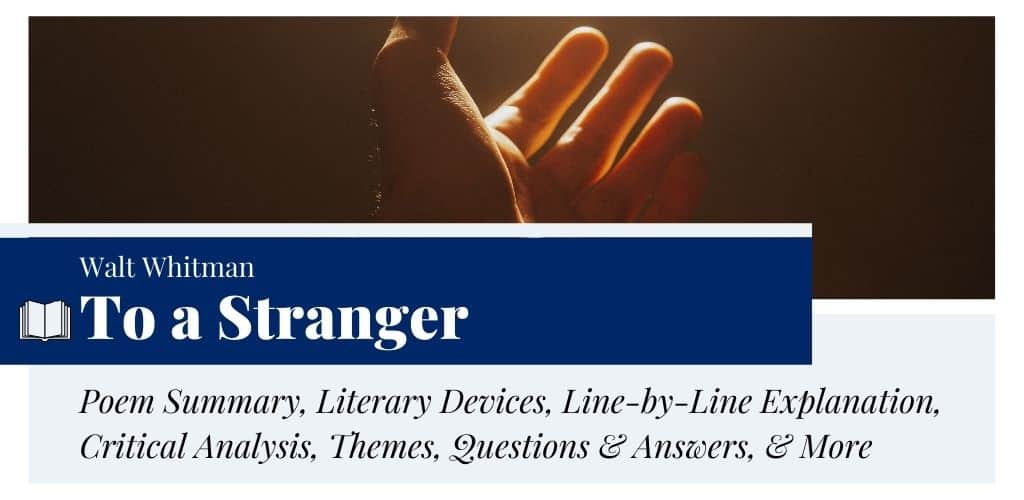To a Stranger by Walt Whitman
“To a Stranger” by Walt Whitman was first published in the 1860 edition of Leaves of Grass in the “Calamus” section, a cluster of forty-five poems. Whitman received both admiration and criticism at that time for this collection. It is considered to be the body of work that brought Whitman to the forefront of American poetic legacy. Considering the billions of people living on earth, there are countless possibilities in which a human is bound to meet strangers in one lifetime.
Is it not strange that we, human beings, belonging to the same genus, live so closely yet are so distant? As humans, we live our lives in similar ways; we face joy and sorrow, we struggle, we dream, and we hope. Yet we cross each other as strangers without exchanging a single word of mere greeting. Whitman addresses this poem to such strangers humans often encounter. Breaking away from conventional perceptions, he talks about the inherent (or divine) connection between human souls, even between strangers who do not know each other.
● Read the full text of “To a Stranger” below:
To a Stranger by Walt Whitman Passing stranger! you do not know how longingly I look upon you, You must be he I was seeking, or she I was seeking, (it comes to me, as of a dream,) I have somewhere surely lived a life of joy with you, All is recall’d as we flit by each other, fluid, affectionate, chaste, matured, You grew up with me, were a boy with me, or a girl with me, I ate with you, and slept with you—your body has become not yours only, nor left my body mine only, You give me the pleasure of your eyes, face, flesh, as we pass—you take of my beard, breast, hands, in return, I am not to speak to you—I am to think of you when I sit alone, or wake at night alone, I am to wait—I do not doubt I am to meet you again, I am to see to it that I do not lose you. - from Leaves of Grass (1860)

Summary
The speaker of the poem “To a Stranger” addresses an individual (“Passing stranger”) whose gender he could not specify. That makes the poem universal in such a way that it feels Whitman’s persona is addressing all his readers. The speaker talks about looking at a stranger “longingly” while thinking about how he possibly could have “lived a life of joy” with him/her in another lifetime. He remembers the different emotions passed by the person, the affections or fluid moments they could have shared, and how they ate and slept together. He thinks he has become a part of the other’s soul so much so that their body was never theirs alone afterward.
While having such thoughts, the speaker looks at the stranger taking in (appreciating) their physical assets and marveling at the joy of perceiving someone that closely. Somehow, perhaps even unconsciously, the stranger would be doing the same. The speaker desires to speak to the stranger; however, social pressures of proper etiquette stop him. But he knows he will think of the stranger at night or when he is alone.
After such thoughts, the poem ends with the speaker’s faith that fate will bring him and the stranger back together again someday. At that time, he would try his utmost best not to lose touch with the stranger again.
Meaning
Whitman was one of the pioneers of the Transcendentalism movement of the 19th-century, a philosophical movement promoting the inherent connection between human bodies, human souls, and the earth. Whitman’s writings reflect this transcendentalist philosophy, and so in his free-verse poem “To a Stranger,” a spiritual connection is explored between two individuals in the most genuine and intimate of ways even if the two individuals are strangers and do not know each other closely.
During the 19th-century, American society was undergoing a number of rapid changes. When the poem is placed in that context, readers can understand that Whitman desires to reverse the distance between people as civilization evolved and circumstances had undergone a mechanical transformation. He puts forward a question on the effect of surroundings on human relationships and how one can immensely influence the other. That’s why he emphasizes emotional tenderness and vulnerability as being most crucial in bridging the growing gaps and distances between humankind. Whitman urges them to have more fulfilling and meaningful interactions with one another.
Form, Rhyme Scheme, & Meter
Structure & Form
Whitman’s “To a Stranger” is written in free-verse. Hence, it does not contain any regular rhyme scheme or meter. Besides, the poem consists of ten comparably long lines (a trademark of Whitman’s poetry) grouped together in a single stanza. Whitman uses the pronouns “you” and “I” to declare his persona is talking from his own point of view. He addresses a stranger (or the audience as strangers) he has encountered in his lifetime. The tone of the poem is intimate and filled with a certain kind of yearning, which once again resonates with the subject matter perfectly.
Rhyme Scheme
Instead of being lyrically rhythmic, it adopts the organic rhythm of the day-to-day conversational speech. It is an important feature since the poem is addressed to readers who are strangers to the poet. Though there is no perfect rhyming between the lines, readers can find the use of internal rhymings, created by using repetitions of words or sounds in a number of instances:
- Line 4: “recall’d” and “matured”; “flit,” “affectionate,” and “chaste”
- Line 6: “ate” and “slept”
- Line 7: “face” and “flesh”
Meter
The poem “To a Stranger” does not have a set metrical pattern. Whitman mainly uses the lines’ rising rhythm (hinting at his underlying optimism) of iambs (da-dum). For instance, in the first line, there are eight iambs: “Pas/-sing strang(e)r!/ you do/ not know/ how long/-ing-ly/ I look/ up(o)n you.” The length of the lines indicates the speaker’s longing and thoughtful mental state. Another critical aspect of the poem is the use of monosyllabic words that not only create a rapid rhythm (resonating with the beating of the speaker’s heart) but also enhances the flow, as in “You give me the pleasure of your eyes, face, flesh, as we pass—you take of my beard, breast, hands, in return.”
Literary Devices & Figurative Language
Whitman’s “To a Stranger” begins with an apostrophe and ends with a confident anaphora; in between, there are a number of literary devices sprinkled across the lines. Let’s have a look at some of the essential devices used in the poem:
Apostrophe
It occurs in the opening lines of the poem. The speaker addresses a “Passing stranger,” with whom he could not have some words. Though the person has left the scene, his/her presence still lingers in the speaker’s mind.
Alliteration
The occurrence of a particular sound at the beginning of neighboring words is called alliteration. Whitman beautifully uses the resonance of sounds in order to create an intricate rhythm while reading, such as the soft “l” sound followed by long vowels (“aw” and “u”) in the very first line. The usage of this device can be found in some other instances as well, provided below:
- “longingly I look” (line 1)
- “seeking, or she” (line 2)
- “somewhere surely”; “lived a life” (line 3)
- “body has become” (line 6)
- “face, flesh”; “beard, breast” (line 7)
- “do not doubt” (line 9)
Repetition
Repetition is another literary device used to emphasize a particular idea or create a resonance of a specific idea (related to the speaker and the stranger). For instance, the speaker repeats the pronoun “you” twice to highlight how much he misses the person in the first line. Similarly, the phrase “I ate with you and slept with you …” throws light at the intimacy of the speaker with the person.
In the last three lines, the repetition serves another purpose. The consecutive use of the phrase “I am” shifts the focus from the stranger to the speaker. Whitman does so in order to elaborate on the mental state of the speaker.
Metaphor
It is not hard to locate a metaphor in the text. One needs to skip to the fourth line and focus on the exemplary usage of the words “flit” and “fluid”. In the first part, “All is recall’d as we flit by each other,” the speaker compares the simple act of passing one by to a swift dance move. The following part begins with the term “fluid,” which metaphorically hints at the memories as fluids running by in the speaker’s mind.
Anaphora
The last three lines of “To a Stranger” begin with the phrase “I am”. It is an example of anaphora which refers to the repetition of a specific word/phrase at the beginning of consecutive clauses or lines for emphasis.
I am not to speak to you—I am to think of you when I sit alone or wake at night alone,
I am to wait—I do not doubt I am to meet you again,
I am to see to it that I do not lose you.
Paradox
Whitman uses a self-contradictory or paradoxical statement in the poem to exemplify the sheer strength of the connection between the speaker and the stranger. The line “your body has become not yours only, nor left my body mine only” contains a paradox. How can two complete strangers share a common body/feelings for each other? Actually, they don’t share the body. Whitman depicts a far greater idea than the simple exchange of truthful emotions. He talks about the connection one human shares with another. This bond exists between two strangers. Thus, they share the same feelings/thoughts as being part of humankind.
Synecdoche
The line, “You give me the pleasure of your eyes, face, flesh, as we pass—you take of my beard, breast, hands, in return” showcases the use of synecdoche. Whitman uses the variety: part for the whole. Separate parts of the human body, such as “eyes,” “face,” “beard,” etc., are written down separately to represent the whole human being. The speaker and the stranger share the inherent beauty within themselves when they pass one another.
Litotes
Litotes is a type of understatement in which an affirmative idea is expressed by the negative of its contrary idea. This device is used in the last three lines of the poem:
I am not to speak to you—I am to think of you when I sit alone, or wake at night alone,
I am to wait—I do not doubt I am to meet you again,
I am to see to it that I do not lose you.
Line-by-Line Explanation & Analysis
Lines 1-3
Passing stranger! you do not know how longingly I look upon you,
You must be he I was seeking, or she I was seeking, (it comes to me, as of a dream,)
I have somewhere surely lived a life of joy with you,
At the beginning of Walt Whitman’s poem “To a Stranger,” the speaker suddenly calls upon a stranger in his mind whom he has encountered on the street. He does not disclose the identity (gender) of the stranger and keeps the audience in anticipation of the further unfolding of the character. The person has a remarkably different impression on his mind, like he is having a déjà vu moment. Somehow, the “passing stranger” strikes a silent chord in his heart, creating a melody of intense longing.
In the second line, Whitman notes that the stranger is the one whom the speaker was “seeking.” Readers have to take note of the verb “to seek” or “seeking”. It is unlike the verbs “finding” or “waiting for.” Rather, it hints at the duration of the speaker’s waiting. He has been seeking (earnestly desiring to meet the person) the stranger for a long time.
Furthermore, the speaker could be a man or woman. Such an outward biological detail is not the speaker’s leading cause of concern. It is the individual living inside the body (the soul) that the speaker is eagerly waiting for. Therefore, the fleeting encounter comes to him “as of a dream.” This encounter is written long before the speaker happened to walk on the face of the earth. It is a part of a dream, a bigger scheme of humankind.
The third line becomes far more musical than the previous ones, as if his thoughts circling around the stranger make him happy. Readers can notice the repetition of the soft “s” and “l” sounds. The speaker is sure of the fact that they have lived a life filled with joy. It could be a reference to their past birth where they were in a relationship. Through this line, Whitman could be alluding to the concept of “Jatismara,” meaning to recollect a former existence of birth in Sanskrit.
Lines 4-5
All is recall’d as we flit by each other, fluid, affectionate, chaste, matured,
You grew up with me, were a boy with me, or a girl with me,
These lines capture the further development of the speaker’s thoughts. The memories of that previous existence come back to him as he and the stranger cross each other. Some memories are like fluids gradually crossing his mind; some capture the affectionate moments between them; some are quite chaste filled with platonic love; the rest consist of matured moments. The terms “affectionate” and “chaste” also indicate the purity of their relationship. They could be related as mother and child, brothers, or sisters.
The speaker believes that they grew up together; such is the closeness he feels with the person. In this line, Whitman again reiterates that the stranger could be a boy or a girl. For the speaker, it is hard to remember even his own gender or how he was related to the person in the past relationship. The memories come to him, but they are not clear. He could only see some flashbacks, not the entire scene.
Lines 6-7
I ate with you, and slept with you—your body has become not yours only, nor left my body mine only,
You give me the pleasure of your eyes, face, flesh, as we pass—you take of my beard, breast, hands, in return,
In the following line, the speaker quite confidently describes how they ate and slept together. They were together in simple moments like eating and sleeping. Furthermore, the speaker could feel how their souls have been entwined due to their spiritual proximity. Now their physical bodies stopped being separate and became one. Such intimacy, both physical and spiritual, is only possible when one loves the other entirely, with one’s entire heart, mind, and body.
In the seventh line, the speaker anticipates how the other person would have felt after the encounter. Firstly, he describes how he feels having just a glimpse of the stranger’s face. It seems as if their whole body radiates the soul’s joy that travels to the speaker and reinvigorates the soul. He thinks the same can happen with the passer-by. They take the pleasure of his whole body, starting from his beard to his hands in return. In this way, Whitman shows the balanced nature of the relationship.
Lines 8-10
I am not to speak to you—I am to think of you when I sit alone, or wake at night alone,
I am to wait—I do not doubt I am to meet you again,
I am to see to it that I do not lose you.
Despite feeling such a deep connection, the speaker remains quiet. He does not speak to the stranger because society does not sanction such casual conversation between strangers. That’s why readers can feel a sense of rejection in the speaker’s voice. The repetition of “I am not” and “I do not” refers to the fact how that external factor hinders their spiritual communication. Somehow, he is confident enough. No matter what, he will take the right course of action in order to sustain this relationship.
Though he is not allowed to speak with the stranger, he can think about the person remotely in his mind whenever he finds himself lonely. The repetition of “alone” hints at the speaker’s sadness as he cannot unite (or talk) with the person. He waits instead of giving up on hope; he nurtures the faith that he will meet the stranger again someday. This time around, the speaker would not lose the person. In this way, Whitman leaves the poem “To a Stranger” open-ended, giving a thread to readers to weave the future development of the plot.
Themes
Whitman witnessed the Civil War and volunteered as a medical help during those terrible years, which left a significant impact on his mind and his writing. He was moved by the suffering, the tenderness, the paradoxical existence of love and hate, cowardice and bravery inside human hearts. Thus, he felt the desperate need to convey these emotions that make human beings the way they are. This particular theme of inherent spiritual and physical connection among humans, which was a rebuttal of the then growing idea of inherent human differences, is what lies at the heart of “To a Stranger.”
Love, the vulnerability of emotions, intimacy, and sharing of struggles and joy are the other themes the poem explores within the context of the speaker’s short encounter with a stranger he feels strangely close to. Through this piece, Whitman asks whether the relationship could have been different too or not if the circumstances had been different.
Historical Background
“To a Stranger” was first published in the 1860 edition of Whitman’s best-loved collection, Leaves of Grass. It appears in the “Calamus” section. Primarily, it was published without the title, bearing the number twenty-two. Critics consider the “Calamus” poems as Whitman’s straightforward expressions of his ideas about homosexual love. This section celebrates different aspects of camaraderie and adhesive love. Whitman probably placed “To a Stranger” in this section due to the presence of a different kind of love and explicit references to the body images that inspire both the speaker and the stranger. In the 1882 edition of Leaves of Grass, the poem was given this captivating title, and the dashes were replaced by commas.
The 19th-century was a period of tremendous and rapid changes for America. Steady urbanization, the Civil War, and socio-cultural changes were the trend of the times. In such an atmosphere, as very well described by the Dark Romantics, there was a rise of a sense of distance and discontent amongst fellow individuals. It was as if human beings were drifting apart from one another. People wore masks and were no longer close; they did not establish meaningful and truthful relationships.
Whitman, a transcendentalist and a believer in the optimistic view of a compassionate string tying all human beings on earth with each other and with Nature, refused to give in to the negativity of the times. Throughout his career, he wrote about the very virtues that connect one human to another and how that gets manifested in daily lives most certainly. This undeniable connection is what the poem “To a Stranger” preaches as well.
Questions and Answers
Walt Whitman’s free-verse lyric “To a Stranger” begins with an impassioned address to a “Passing stranger.” The speaker continues to describe the mental impression the stranger has on his mind. Throughout the poem, he elaborates on the relationship they had in some past life, long forgotten yet vibrant on the soul’s canvas. The silent chord in the speaker’s heart is struck by a simple glimpse of the person (or the one living inside, the soul). As the overall poem is about the stranger’s significance in the speaker’s life, the title is apt, and it resonates with the subject matter.
In Walt Whitman’s “To a Stranger,” the stranger is not just another passer-by one happens to encounter. Hence, the speaker feels a specific connection with the person that he tries to explain in this poem. Besides, the poem explores the vital connection between all individuals on earth despite their varied experiences. One just requires the eyes to see, the heart to feel, and an open mind to make strangers their close acquaintances.
Society sets certain standards and boundaries in human interactions. Talking to a random stranger is somehow considered wrong and not expected, which is why the speaker refrains from doing something that will make others raise their eyebrows at his act. This shows how social norms and individual circumstances affect potential actions and relationships.
The speaker feels that he and the stranger must have grown up together and taken part in the shared activities of eating and sleeping. He, therefore, feels he has known the stranger for a long time and takes in the stranger’s physical appearance with admiration. Somehow, he is sure about the fact that the stranger is unconsciously doing the same because of their strong physical and spiritual connection.
In the last few lines of “To a Stranger,” the speaker says that he has lost someone close to him. That is why he says that he would be thinking about the stranger whenever he feels alone, and he believes in meeting them at some point. If he is fortunate enough to find a strong connection like that again in life, he will try his best not to lose the precious person for a second time around.
Explore More Walt Whitman Poems
- “One’s Self I Sing” — In this piece, Whitman celebrates the “self,” devoid of any negativities; he upholds the “modern man” in him.
- “A child said, What is the grass?” — This poem raises an essential question related to Leaves of Grass: “what is the grass?” Whitman provides the answer in this piece.
Similar Poems about Human Relationships
- “I cannot live with You” by Emily Dickinson — In this poem, Dickinson explores the intricacies of a relationship that is about to end.
- “Love in a Life” by Robert Browning — This poem deals with the turmoil of a heartbroken, desperate lover trying to “hunt” his beloved all over his house.
- “My True Love Hath My Heart” by Sir Philip Sidney — This piece describes how the exchange of truthful emotions creates a homeostatic relationship.
- “I wish I could remember that first day” by Christina Rossetti — It’s about a speaker reminiscing her first love and her regrets that surface with aging.
External Resources
- Check out Leaves of Grass (150th Anniversary Edition) — This special edition of Leaves of Grass captures the design and layout of the original edition supervised by Whitman himself!
- About Leaves of Grass — Learn about the publication history and background, different editions, and critical reception of the collection.
- A Guide to Leaves of Grass — Read this guide to some of the important Whitman poems from this collection.
- Biography of Walt Whitman — Explore the incredible facets of Whitman’s life and his poetry.
- About Whitman — Learn more about the poet’s life and read some of his well-known poems.




